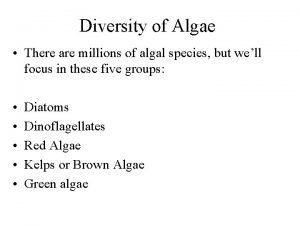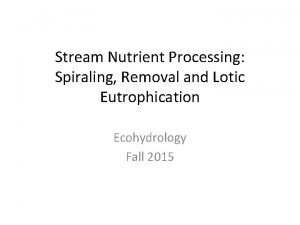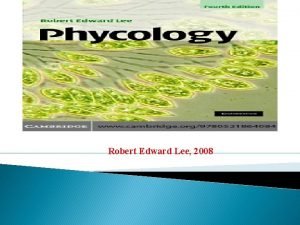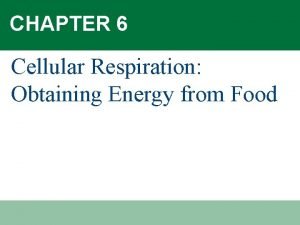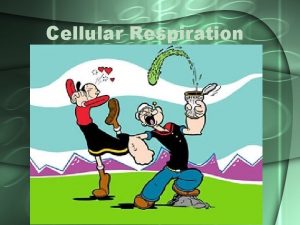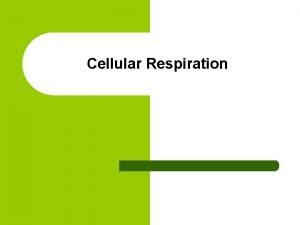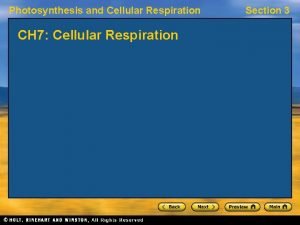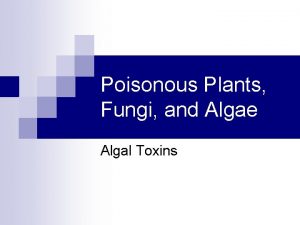Algal cellular respiration Cellular respiration in algae as










- Slides: 10

Algal cellular respiration Cellular respiration in algae, as in all organisms, is the process by which food molecules are metabolized to obtain chemical energy for the cell. Cellular respiration is the reverse reaction of photosynthesis, but chemically, the steps involved are very different. C 6 H 12 O 6 + 6 O 2 ---> 6 CO 2 + 6 H 2 O + ~38 ATP

One objective of the degradation of foodstuffs is to obtain ATP. In eukaryotic cells the enzymes of respiration are located in mitochondria. In microorganisms the enzymes occur as components of the cell membrane. Cellular respiration consists of three metabolic processes: glycolysis, the tricarboxylic acid cycle (TCA cycle; also known as the Krebs, or citric acid, cycle), and oxidative phosphorylation (respiratory-chain phosphorylation

Glycolysis This step happens in the cytoplasm. During glycolysis, one Glucose (C 6 H 12 O 6) is broken down to 2 molecules of pyruvic acid resulting in the production of 2 ATPs for every glucose. Four phosphate groups are transferred to ADP by to make four ATP, and two NADH are produced when the pyruvate are oxidized. Glucose + 2 NAD+ + 2 Pi + 2 ADP → 2 pyruvate + 2 NADH + 2 ATP + 2 H+ + 2 H 2 O+energy

Pyruvate is oxidized to acetyl-Co. A and CO 2 by the pyruvate dehydrogenase complex in mitochondria. In the conversion of pyruvate to acetyl-Co. A, one molecule of NADH and one molecule of CO 2 is formed. This step is also known as the link reaction or transition step, as it links glycolysis and the Krebs cycle. .

Krebs cycle or the tricarboxylic acid cycle Once acetyl-Co. A is formed, two processes can occur, aerobic or anaerobic respiration. When oxygen is present, the mitochondria will undergo aerobic respiration (Krebs cycle). if oxygen is not present, fermentation of the pyruvate molecule will occur. Pyruvate enters the Krebs cycle inside the mitochondrial matrix, and gets oxidized to CO 2 and at the same time, NAD is reduced to. NADH can be used by electron transport chain to create ATP as part of oxidative phosphorylation

The citric acid cycle is an 8 -step process involving different enzymes and co-enzymes. Throughout the entire cycle, acetyl-Co. A(2 carbons) is converted to Oxaloacetate. The net energy gain from one cycle is 3 NADH, 1 FADH 2, and 1 ATP. Thus, the total energy yield from one whole glucose molecule (2 pyruvate molecules) is 6 NADH, 2 FADH 2, and 2 ATP

Oxidative phosphorylation In eukaryotes, oxidative phosphorylation occurs in the mitochondrial cristae. Oxidizing the NADH produced from the Krebs cycle. ATP is synthesised by the ATP synthase enzyme from ADP and Pi. The electrons are finally transferred to exogenous oxygen and, with the addition of two protons, water is formed.

cycle

ATP

Primary production (algae) acts as both a source and sink of dissolved oxygen. During daylight hours algal photosynthesis produces oxygen in excess of algal demands (respiration), often resulting in dissolved oxygen levels in excess of saturation, i. e. , supersaturation. During nighttime periods when photosynthesis is absent, algal respiration may reduce dissolved oxygen levels significantly.
 Algae biodiesel
Algae biodiesel Algal
Algal Algal growth
Algal growth Pyrrophyta algae
Pyrrophyta algae The closest algal relatives of land plants are
The closest algal relatives of land plants are Pseudoparenchymatous algae
Pseudoparenchymatous algae Cellular respiration obtaining energy from food
Cellular respiration obtaining energy from food What is produced in cellular respiration
What is produced in cellular respiration Explain how amp stimulates cellular respiration
Explain how amp stimulates cellular respiration Overall reaction of cellular respiration
Overall reaction of cellular respiration Section 3 cellular respiration continued
Section 3 cellular respiration continued

